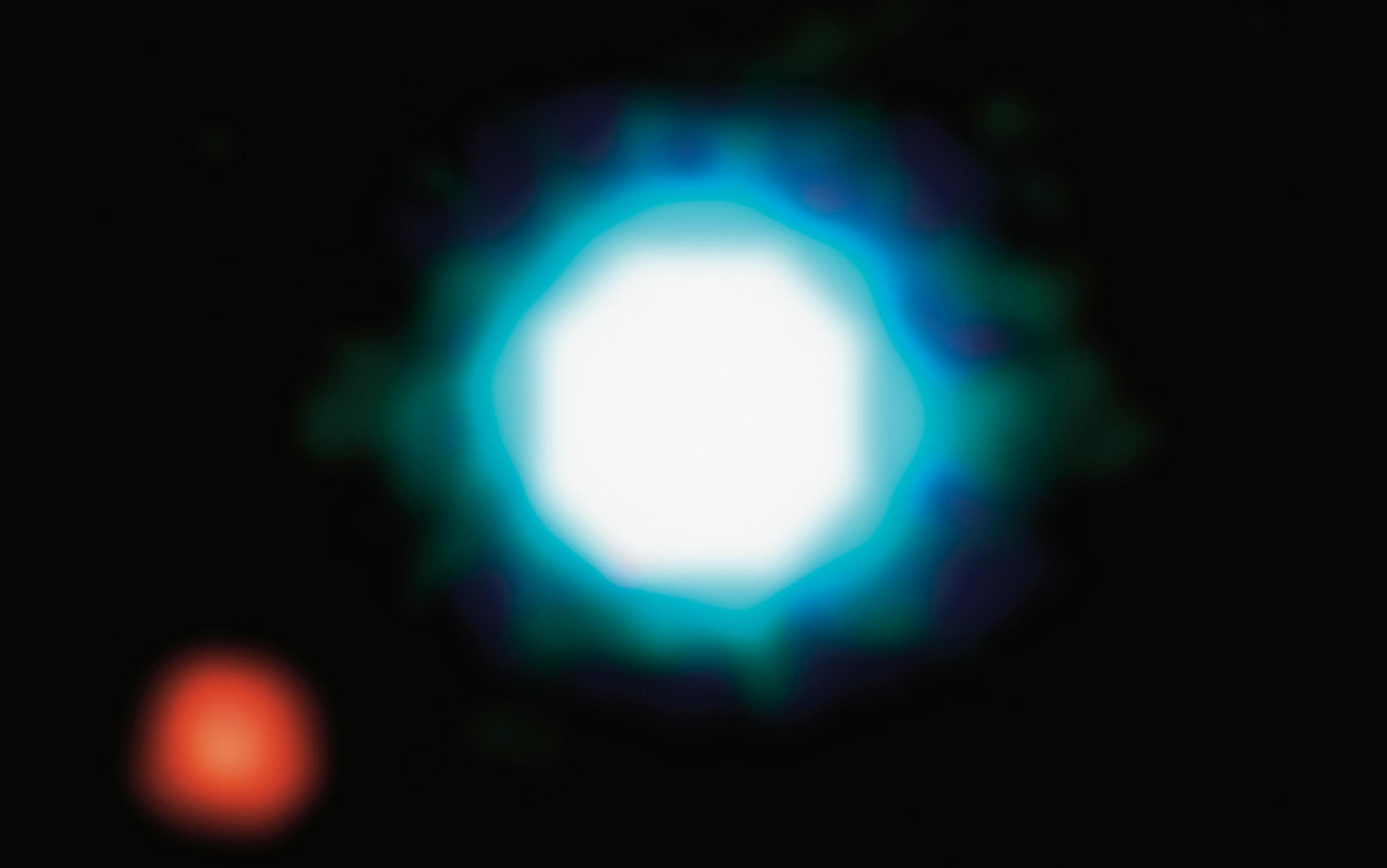Are we alone in the Universe? And if not, should we be excited – or afraid? These questions are as immediate as the latest Netflix hit and as primal as the ancient myths that associated the planets with spirits and gods. In 1686, Bernard le Bovier de Fontenelle, the long-term secretary to the French Academy of Sciences, put an Enlightenment stamp on speculations about alien life with his book Entretiens sur la pluralité des mondes (Conversations on the Plurality of Worlds). In a series of spirited philosophical conversations, he declared that ‘it would be very strange for the Earth to be so well inhabited, and the other planets perfectly solitary’, and argued that alien beings might attempt to communicate with us or even visit us using some advanced form of flight.
Ever since, each age has featured its own version yearning for contact with life from beyond, always anchored to the technological themes of the day. In 1818, the German mathematician Carl Friedrich Gauss proposed communicating with aliens using a heliotrope, a system of mirrors that he devised to send coded signals using reflected sunlight. After the development of early electric lights, the French inventor Charles Cros suggested that such lamps could be amplified to beam messages to Venus or Mars. Nikola Tesla wrote in 1900 that ‘interplanetary communication has entered the stage of probability’ using newfangled radio waves. A year later, he reported that he had detected likely signals broadcast from another world.
Then the search got stuck. Radio persisted as the alien-hunting medium of choice, even as technology continued to change faster than ever. A full century after Tesla, researchers engaged in the search for extraterrestrial intelligence (commonly shortened to SETI) were still scanning the heavens with antennas and listening for artificial radio transmissions incoming from other worlds. The efforts led to ever-tightening statistical upper limits and a handful of briefly exciting false alarms, but mostly a whole lot of nothing.
Getting the SETI field moving again required more than a specific new technology; it required a new way of thinking about technology as a whole. ‘I was never a big fan of what might be called “beacon SETI”,’ the astrophysicist Adam Frank from the University of Rochester tells me. ‘The idea is that you’re waiting for somebody to send you a message with radio, but I thought, maybe nobody wants to do that.’ Frank is one of the leading researchers embracing a different approach, one that focuses on the hunt for ‘technosignatures’: evidence of any kind of alien technology that modifies its environment in detectable ways.
The shift from SETI to technosignature is an intellectual sea change in thinking about what extraterrestrials could be, and about how they might reveal themselves to us. The emerging science of technosignatures has also reopened a high-stakes, long-dormant debate. To make contact, do we need to stop just listening and start talking as well? Or is announcing our existence to the Universe an invitation to destruction?
SETI sprung from the Space Age mindset of the 1950s, when rocket scientists were drafting plans to send the first spacecraft to other planets and astronomers were beginning to conduct detailed studies of radio emissions from distant cosmic objects. Frank Drake, a radio astronomer at the National Radio Astronomy Observatory (NRAO) in West Virginia merged those twin themes in his head and began wondering whether intelligent creatures on those other worlds might similarly be looking outward and attempting to contact us via radio waves, signals that could be detectable using radio dishes such as NRAO’s 85-foot antenna.
In 1960, Drake conducted Project Ozma, the first dedicated attempt to seek out messages from extraterrestrial civilisations, scanning the sky with the 85-foot dish and using a loudspeaker to listen for any messages hidden within the static. His small-scale project drew significant media and academic attention. A year later, Drake convened the first SETI meeting, drawing a dozen leading researchers to discuss the prospects for expanding and formalising the search. One of the young astronomers swept into this strange new field of study was Jill Tarter, who rose to become the project scientist for the biggest SETI initiative to date: an ambitious NASA project called the High Resolution Microwave Survey.
NASA’s effort launched with shiny hopes in 1992. A year later, it was in ruins. Senator Richard Bryan from Nevada had singled it out as an egregious example of government waste, and launched a withering assault on what he called ‘The Great Martian Chase’. Congress not only shuttered the High Resolution Microwave Survey, it effectively banned NASA from funding any further research along those lines. Tarter soldiered on, co-founding the nonprofit SETI Institute to pick up her research with private support, but the field retreated to the margins of respectability.
With the exoplanet boom, the possibility of life on other planets was no longer philosophical speculation
The grand pause had set in. What nobody realised at the time, though, was that a little-known pair of Swiss astronomers was already laying the groundwork for SETI’s grand revival. In 1993, just as Senator Bryan was sneering that ‘not a single Martian has said “take me to your leader”’, Michel Mayor and Didier Queloz at the Geneva Observatory had completed a sensitive new instrument for discovering exoplanets, worlds beyond our solar system. In 1995, they reported spectacular success, finding the first known planet orbiting another star similar to the Sun. As soon as their colleagues understood where and how to search, other detections followed at an ever-accelerating cadence. The current exoplanet tally stands at more than 4,500.

With the exoplanet boom, the possibility of life on other planets was no longer just a matter of philosophical speculation; suddenly, it lay within the reach of empirical investigation. Researchers coined a new word, ‘biosignatures’, to describe chemical evidence suggestive of biological activity on another world. On Earth, for instance, oxygen is produced by photosynthesis and methane gas is created by microbes eating organic matter. The two gases readily react with each other, so methane would quickly disappear from an oxygen-rich atmosphere unless it were steadily replenished. Finding oxygen and methane together on an exoplanet would therefore be strong circumstantial evidence of life.
Tarter quickly recognised that biosignatures had huge implications for SETI as well. Any observable signal of metabolic activity (even the huffing and puffing of slime mould) qualified as a biosignature. She wondered: what about the equivalent observable signals of deliberate, technological activity – technosignatures? Humans alter Earth in a million ways without deliberately intending to tell the cosmos that we are here. We spew pollutants, belch factory heat during the day, and light up our cities at night. We can’t help it, any more than bacteria can help emitting methane. By extension, any advanced aliens could be expected to visibly alter their planet as an inevitable byproduct of creating a manufactured, industrial civilisation.
In a presentation to the International Astronomical Union in 2006, Tarter outlined this new concept and argued that SETI needed to be defined more broadly. It was time, she stated, to pursue any clues pointing to the existence of nonhuman technology out there: ‘Then we will be permitted to infer the existence, at least at some time, of intelligent technologists.’
The breakthrough moment in the rebranding of SETI came in the fall of 2018, when NASA convened a Technosignatures Workshop in Houston, Texas. The meeting drew together both veteran alien-hunters but also many other scientists, such as Adam Frank, who had never given SETI a serious thought. Frank develops detailed computer models of stellar evolution and had no interest in spending years sifting through radio noise in the hopes of hearing somebody say hello. But the idea of technosignatures piqued his interest because it shifted the focus away from one specific action that aliens might or might not perform – sending signals – to the general process of how intelligent aliens might live. ‘It’s much more interesting to look for things like climate change, things that just happen if you are a civilisation,’ Frank tells me.
Along with fresh thinking, the Technosignatures Workshop also promised the magic elixir that SETI research had been missing for a quarter of a century: NASA funding. The discovery of exoplanets had given the agency both scientific motivation and political cover to resume support for alien-hunting. It was easy to deride SETI as a search for Little Green Men. Biosignatures research, in contrast, was a sober-sounding observational programme for detecting the spectroscopic markers of specific compounds on other planets. (Try laughing at that, Senator Bryan.) Biosignature grants sailed through the approval process smoothly, easing the way for technosignature grants to follow.
Two decades of exoplanet research had also established that the search for technosignatures, while challenging, is clearly possible. Some exoplanets are aligned so that they appear to pass directly in front of their stars as seen from Earth. When that happens, starlight streams through the planet’s atmosphere and a small fraction of that light gets absorbed by the gases there, indicating activity and chemistry on the surface. In other cases, it is possible to pick up a smidgeon of starshine reflected directly off the planet’s surface. By examining these exceedingly subtle effects, researchers have already identified sodium, water, carbon dioxide and other molecules – even oxygen and methane, though not together – on these far-off worlds. Artificial compounds might be rarer and harder to find than natural ones, but in principle the detection process is the same.
If aliens want to convert the light from their star into emission-free energy, solar panels are a logical way to do it
Last year, Frank and a group of collaborators were awarded NASA’s first-ever grant for technosignatures research, bringing SETI’s great pause to an end. The group zeroed in on energy-generation and manufacturing as two essential aspects of an industrial civilisation, and then sought out plausible ways that we could see those things happening from many light years away. Drawing on earlier papers by Avi Loeb at Harvard University, the researchers settled on two signals in particular: solar panels and chlorofluorocarbons, or CFCs.
If aliens want to convert the light from their star into emission-free energy, the reasoning goes, solar panels are a logical way to do it. And if they decide to go all-in and blanket their home world with those panels, they would significantly alter the appearance of their planet: sunlight glinting off a photovoltaic array looks a lot different than sunlight reflecting off a lake or a rock. Better still, solar panels make the planet look different in predictable ways, regardless of the specific energy technology another civilisation might develop. ‘There’s just a limited number of useful elements available to you, whether you’re an alien or not,’ Frank says. His group is now modelling the appearance of various plausible types of solar installations and assessing what it would require for us to observe them on a world around another star.
Chlorofluorocarbons are a more human-specific technology, but a promising starting point for exploring what Frank calls ‘atmospheric technosignatures’ – that is, any distinctive substance that an industrial civilisation puts into the air. CFCs are highly versatile compounds that are used as solvents, refrigerants, foaming agents and aerosol propellants. If we find these chemicals so appealing, maybe other species will, too. One big caveat is that CFCs damage the ozone layer and are being phased out here on Earth; it’s odd to imagine advanced aliens recklessly polluting their home world. Then again, they might not need an ozone layer. They might live underground, Frank notes, or might have relocated their factories to an uninhabited service world. CFCs also are effective at trapping heat. Maybe aliens use them for planetary climate control?
From a technosignatures perspective, CFCs are especially interesting because they do not exist in nature and they are easy to detect even at low concentrations. They are therefore a good starting point for learning how to model the effect of an artificial chemical in an exoplanet atmosphere, design the right observing technique to look for it, and then pick out its visible signature amid the vastly brighter glare of the planet’s nearby star. Think of CFCs as the gateway drugs to innumerable other, more bizarre visions of possible extraterrestrial civilisations.
Therein lies one of the greatest challenges of the technosignatures hunt. Alien technology could take so many forms that it is impossible for the human mind to consider or even imagine them all. The best we can do is start with the technology we know and extrapolate outward as creatively as possible.
‘What we really want to do is systematically think about the possibilities and come up with a library of technosignatures,’ Frank says. In a piecemeal manner, some researchers have already begun doing that. Ravi Kopparapu, a planetary scientist at NASA’s Goddard Space Flight Center, is intrigued by nitrogen dioxide, a byproduct of combustion or high-temperature manufacturing. Next-generation space telescopes should be able to detect Earthly levels of nitrogen dioxide on a planet 30 light-years away, he finds. Others have suggested looking for heavy-metal industrial contamination or even for the nuclear flash from an off-world atomic war. These ideas have not yet been so well quantified, however.
Technosignatures also don’t have to take the depressing form of pollutants. Artificial illumination has a spectrum that is quite distinct from starlight, meaning that it might be possible for future telescopes to pick up the nighttime glow of majestic alien metropolises. Any known process that uses energy, no matter how clean, also gives off heat. Scanning for unusual infrared thermal emissions would be another way to identify cities or industrial parks on exoplanets. These signals would be even more subtle than the ones from CFCs or solar panels, unfortunately. We would be unlikely to spot them through current means of detection unless extraterrestrial civilisations operate on a scale vastly beyond anything humans have done.
Then again, why shouldn’t they? Once we break free from the shackles of our own limitations, we can imagine aliens performing wild feats of planetary or interplanetary engineering. Jason Wright at Pennsylvania State University, a leading SETI researcher (and one of Frank’s collaborators) has written extensively on the possibility of discovering such alien artefacts – what might be called mechanical technosignatures. For instance, an extraterrestrial civilisation that has outgrown its planet might build a megastructure around its star, to create more living area or to capture all of the star’s energy. In this case, we might observe not the byproduct of the technology, but the technology itself: from afar, a star would begin to flicker, then wink out as the structure is completed, leaving only the infrared warmth of the megastructure.
Alien tech could be millions or billions of years old
Six years ago, it seemed like that might have happened. The astronomer Tabetha Boyajian (then at Yale, now at Louisiana State University) helped identify a bizarre variable star that did not behave like anything seen before. Even her sober-minded colleagues had to admit that they couldn’t decisively rule out an alien megastructure. The current astronomical consensus is that Boyajian’s Star is something less exotic, like a young star surrounded by eccentric rings of dust from a shattered planet or moon. Still, the controversy helped draw attention to the emerging field of technosignatures, and it got Wright thinking more actively about how to investigate alien artefacts in a responsible and scientifically rigorous manner.
The issue of rigour becomes especially touchy when researchers like Wright consider the possibility that extraterrestrial civilisations might have sent artefacts here, into our own solar system, if not onto Earth itself. Wright is acutely aware that scanning for nearby alien technology sounds suspiciously like hunting for UFOs, and he would like to stop you right there. (He recently wrote an essay for Slate explaining the stark difference, titled ‘I Look for Aliens for a Living, and No, I Don’t Study UFOs’.) From a technosignatures perspective, it seems ludicrous that creatures capable of interstellar travel would be buzzing around Earth in flying saucers at this exact moment in our planet’s 4.5-billion-year history, playing hide-and-seek with US fighter jets like a bunch of bored teenagers. That is exactly the kind of blinkered, human-centric thinking that the researchers are trying to steer away from.
Wright has a much more expansive view of alien tech. It could be millions or billions of years old. It could take the form of an automated space probe, but it could also be derelict, or it could be trash left by an ancient research expedition, akin to the remains of the Apollo missions. Only after you adjust to this more openminded way of thinking can you begin to develop plausible methods for identifying the kinds of technosignatures that might be lurking right in front of us.
For starters, looking for alien tech on Earth is probably a waste of time. ‘It’s a geologically active place, and, on top of that, life destroys everything quickly here,’ says Wright. Better to search on the Moon, where any structures or equipment left behind by visitors could remain intact for aeons. Image searches or radar scans could expose unusual-looking structures with right angles or with out-of-place material properties. Aliens might also monitor our solar system for a long time by parking space probes in extremely stable orbits. The stability requirement rules out a lot of real estate, Wright notes, but it leaves locations like the asteroid belt where an ancient craft could blend in with the surrounding small rocks. Fortunately, there are a few possible giveaways.
An artificial object might stand out by its distinctive colour and composition. It would probably be hollow, with a much lower density than a typical asteroid, which would cause its orbit to shift due to the pressure of sunlight. If it is currently active, we might even catch it while it is thrusting and adjusting its trajectory. Starting in 2023, the Rubin Observatory in Chile will begin by far the most extensive survey of small objects in the solar system. Wright is eager to build an alert system so that, any time the telescope detects something that doesn’t look quite right, it will flag that object as a potential technosignature deserving closer scrutiny.
In all of its permutations, the technosignatures approach stays true to its central premise, that we might detect extraterrestrial civilisations whether or not they have any interest in being detected. The principle of transparency cuts both ways, however. Just as aliens could be exposed to us simply by what they do, so too are we exposed to them by what we do. A study published earlier this year in Nature identified 1,715 nearby star systems that would see Earth passing in front of the Sun. That alignment creates the ideal setup for studying our atmosphere and gleaning the secrets of our industrial society – dirty CFCs, nitrogen dioxide, and all.
Science-fiction stories are full of warnings against broadcasting our existence to extraterrestrials, who might harm us if they know where we are; it’s a central theme in Cixin Liu’s recent The Three-Body Problem trilogy, for example. Traditionally, most scientists have also been squeamish about signalling projects. Stephen Hawking was especially outspoken against the idea. But the technosignatures concept suggests that these concerns are rooted more in fear than in logic. That is the view of Douglas Vakoch, a psychologist and astrobiologist who used to work for Tarter at the SETI Institute and has since founded his own organisation, METI International. ‘There’s a sense that it’s a wild jungle out there, so we better hide,’ he tells me. ‘The reality is, it’s too late to hide, so what do we do in light of that?’
The name of Vakoch’s organisation hints at his answer. METI stands for Messaging Extraterrestrial Intelligence, essentially SETI in reverse. Vakoch and a small community of likeminded METI advocates are starting to think of ways to get out the interstellar messages that we want, rather than the ones that just happen to slip out by accident. Our technosignatures are already out there for all to see, they note, and nothing bad has come of it. We probably don’t have to worry, then, about the danger of announcing ourselves to a potential off-world audience.
‘Creatures that communicate through a sense of smell … would have a different sense of time and space’
If we let go of that fear of speaking, we can dig into the rich and fascinating issue of what it is that we would want to say. So far, there have been only a handful of attempts at beaming out interstellar messages. The most famous of these was the first one, a radio signal designed by SETI pioneer Frank Drake and directed toward the star cluster M13 in 1974. The transmission contained coded images of DNA, a person and the radio telescope used to transmit the message. Drake made a sincere effort to think universally, but still ended up incorporating a lot of assumptions about how aliens perceive reality. ‘Imagine creatures that communicate primarily through a sense of smell. I’d argue that they would have a fundamentally different sense of time and space,’ Vakoch says.
A more essential limitation in the 1974 message (and in the few that followed, as well) is that Drake didn’t seriously address why anyone at the other end would care enough to send a reply. Statistically speaking, any alien civilisation we are able to contact is likely to be far older than our own. It is likely to be far more technologically advanced as well. ‘What can we offer that would have some value to them?’ asks Vakoch. Perhaps we could offer them a reminder of their own origins, he suggests, or a perspective on the other ways that intelligent beings can develop. Maybe they would respond just out of kindness and concern for the upstart humans of Earth – but maybe not. Pondering the potential motivations of extraterrestrial societies is a next-level task for technosignatures research.
An absence of motivation might also explain the Fermi Paradox – the lack of any communication from alien civilisations, even though our galaxy seems to contain a multitude of potentially habitable planets. If they know we’re here, why don’t they call? It’s possible, of course, that intelligent extraterrestrials do not exist. But it’s also possible that we have not yet given them any reason to be interested in us. The late Ronald Bracewell, an electrical engineer at Stanford University, described SETI as an attempt to join the Galactic Club. ‘But that assumes we’re going to get an invitation unsolicited,’ Vakoch says. ‘Any club I’ve wanted to join, I’ve needed to submit an application, and then I’ve needed to pay my dues if I’m accepted.’
If Vakoch is right, listening alone won’t do the trick. Making our mark with air pollution and city lights won’t cut it, either. The only way to join the Galactic Club is to take control of our own technosignature and announce loud and clear: ‘We’re here – and we’ve got something really amazing to tell you if you respond.’
This Essay was made possible through the support of a grant to Aeon+Psyche from the John Templeton Foundation. The opinions expressed in this publication are those of the author and do not necessarily reflect the views of the Foundation. Funders to Aeon+Psyche are not involved in editorial decision-making.






